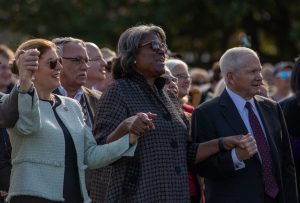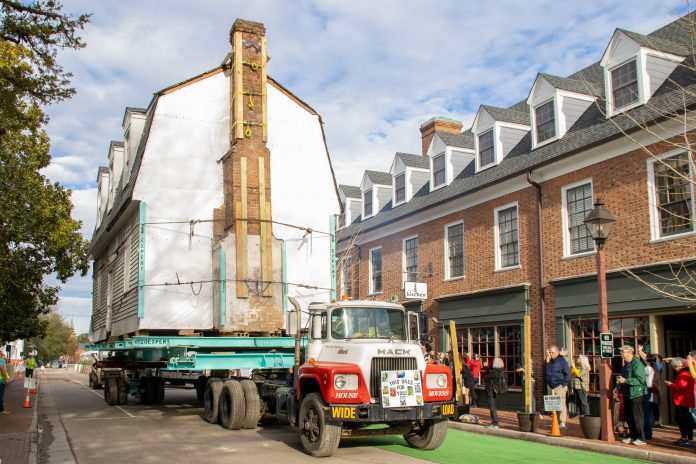Friday, Feb. 10, the Williamsburg Bray School, the oldest surviving school for free and enslaved Black children in the United States, paraded 0.4 miles over the course of two hours to its new location on the corner of Nassau and Francis Street.
This historic move is a result of 20 years of research that started with College of William and Mary Chancellor Professor Emeritus of English Dr. Terry L. Meyers and her discovery of the school’s original site in 2002. Other scholars confirmed her discovery using dendrochronology, the scientific method of dating, in 2021. The building moved from its original location in 1930, and most recently housed offices for the College’s Department of Military Science.
“This could only happen in Williamsburg,” Mayor Doug Pons said at the launch event.
On the recommendation of Benjamin Franklin, the Associates of Dr. Bray – an English philanthropic organization which funded the religious education of enslaved African Americans – financed the founding of the school. Its sole teacher, Ann Wager, taught 300 to 400 Black children reading, writing, arithmetic and Anglican teachings between 1760 and 1774.
The Bray School, resting in a truck bed on steel beams, made its way to the launch ceremony, passing members from the College, Williamsburg and broader communities. Students from Matthew Whaley Elementary School held signs containing the names of former Bray School students.

The building arrived at its new permanent location in the morning. By 2 p.m., hundreds of Williamsburg residents and curious onlookers had arrived to celebrate the occasion at the Williamsburg Bray School Preservation Launch Ceremony across the street on the lawn of the Art Museums of Colonial Williamsburg.
Colonial Williamsburg interpreter John Ingram Jr. – who portrays the pastor and founder of the First Baptist Church, Reverend Gowan Pamphlet – discussed the discovery’s contradiction to the notion that all enslaved Americans were uneducated.
“This is an incredible story that very few know about,” Ingram Jr. said. “This is going to change the teaching in our education system and our curriculum in the United States of America because we have always said that it was illegal for slaves to be taught how to read and write… [Colonial] cities are where these schools were because city slaves had a need to understand the basic rudiments of reading, writing, ciphering, basically to do their city jobs.”
The move is the result of a historic partnership between the College, Colonial Williamsburg and the City to research and teach a more inclusive American history.
“We talk about making the whole greater than the sum of its parts,” College President Katherine Rowe said. “That is what is happening around the Bray School. That is what it looks like and feels like when a city and the world’s largest living museum and one of our oldest and greatest universities and a community of descendants and community of faith come together in a new discovery.”
The Bray School Preservation Launch highlighted histories long neglected by the public, specifically that of African Americans and the First Baptist Church. The school’s history is deeply entwined with the Church, which met secretly beginning in 1776.
“[The school’s students] would become the pillars of the community of the First Baptist Church,” Ingram Jr. said.
He discussed the Bray School’s move in the context of Colonial Williamsburg’s plans to reconstruct a model of the 19th-century wooden First Baptist Church by 2026, the 250th anniversary of American independence. The restoration plans came after Colonial Williamsburg bought the plot of land in 1958, demolished the church and turned it into a parking lot.
“This is literally my 25-year-old dream that I did not think I would ever see,” Ingram Jr. said. “This is something that’s come to fruition that not only this building, but the First Baptist Church building, which I never thought I would see either, has come true.”
Numerous political, cultural and educational leaders attended the launch event, in addition to Bray School descendants, friends and the local community. Guests included U.S. Ambassador to the United Nations Linda Thomas-Greenfield, College Chancellor Robert M. Gates ’65, L.H.D ’98, Virginia tribal leaders, members of the CW and College boards, Mayor Doug Pons, Congressman Rob Wittman (VA-01) and Virginia Governor Glenn Youngkin.
“This building…offers us an opportunity to study the intersection of race and religion in education and what it meant to the development of our society,” Colonial Williamsburg President and CEO Cliff Fleet said. “But it also offers us the opportunity to lift up voices that for too long have been unheard. The children educated in this building contributed to the birth and the growth of this nation, And we need to elevate those voices and explore those histories to understand the contributions that they had to the formation and growth of Williamsburg, the Commonwealth and the nation.”
Youngkin struck a religious tone in his speech.
“As I personally reflect on our history, on Virginia’s history, on our nation’s history, I see more clearly the mighty role the church and the classroom played in the progress toward the goal of all people being equal,” Youngkin said. “In the face of the grave, unconscionable injustice of chattel slavery, the children attending the Bray School learned to read. They learned to write. And in the small classroom that we honor today, these children, God’s children, learn to read His word, the Bible.”
He also spoke about his view on the dynamic nature of history.
“We have to remind ourselves frequently that our understanding of our collective history is constantly growing in truth and clarity,” Youngkin said.
Although the instructors at the Bray School provided an education to children who would not have otherwise received one, they also taught the enslaved children of the school that slavery was God’s will. Two enslaved people owned by the College are known to have attended.
“We must teach all of our history, all of it, the good and the bad,” Youngkin said. “We must expand. We must expand our understanding of our rich heritage and forge together a better future through education.”
Fleet placed the Bray School and the First Baptist Church in the context of Williamsburg and colonial America.

“So many seminal events that shaped us as a nation happened within blocks of where I sit today,” Fleet said. “The economic, social and political fabric of our nation was created here, right here in Williamsburg. And that is why we exist.”
Mayor Pons spoke about the recently created Truth and Reconciliation Committee, which aims to study the impact of racism and racial injustice in Williamsburg. Future plans include the creation of an African American Heritage trail that will weave through downtown Williamsburg, the College and Colonial Williamsburg, undoubtedly stopping by the Bray School.
Director of the William and Mary Bray School Lab Maureen Elgersman Lee read a history of the school during the ceremony. Adam Canady, Tonia Cansler Meredith and Robert “Bobby” Braxton, (descendents of Bray School students) along with Colonial Williamsburg’s Wager interpreter Nicole Brown, read the 86 known names of the school’s students.
“I am so humbled by the past,” Youngkin said to conclude his speech. “I am ever more optimistic about our future. I’m so grateful for all of your presence. And I am truly overwhelmed by the names of the 86 children that were spoken today. My dear friends, I am so confident that together with God as our witness, we will lock arms and we will unite for our brightest days ahead.”
First Baptist Church Director of Music Reginald Fox closed out the ceremony leading a hymn called “Unity.” Audience members and dignitaries alike held hands and sang along.

